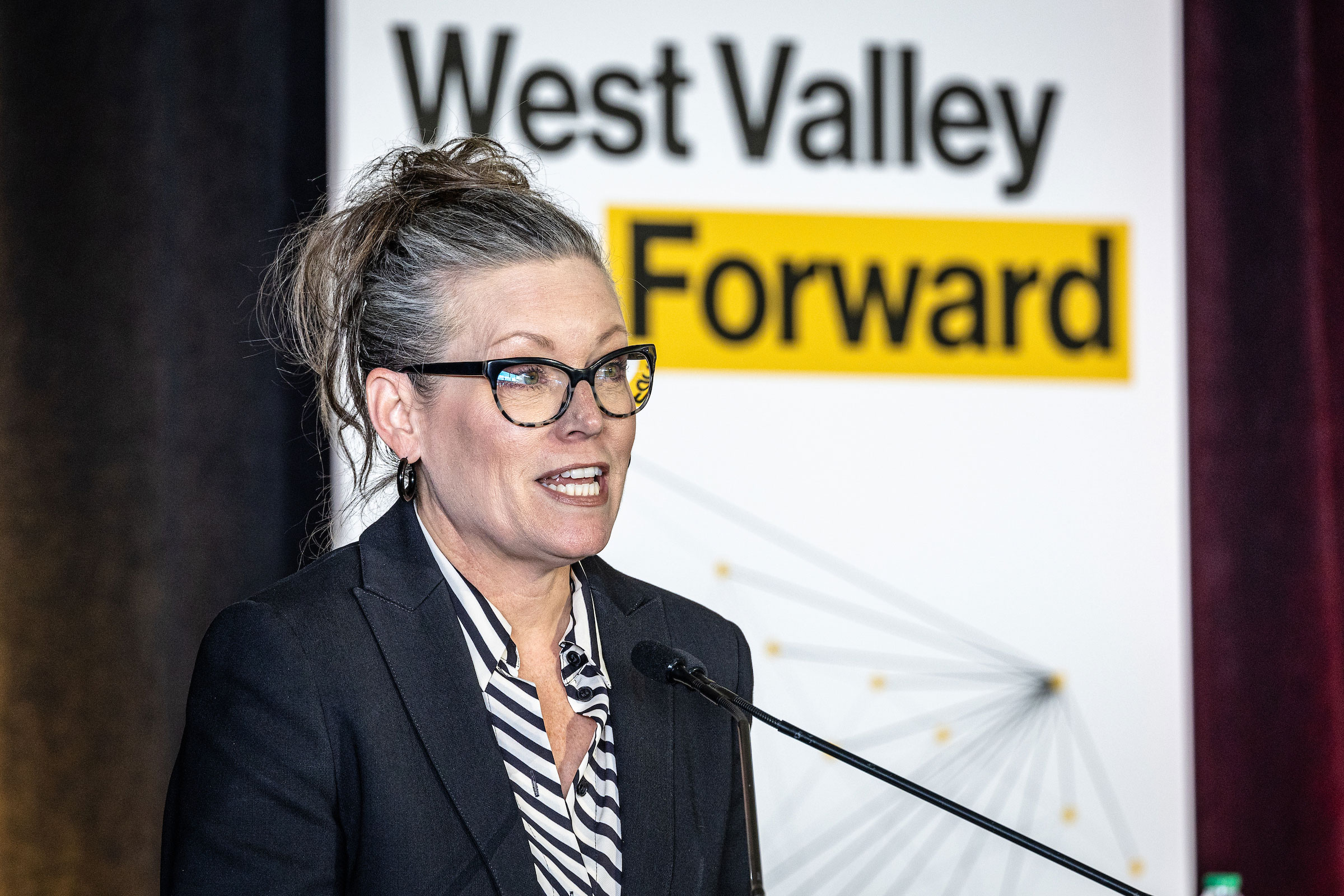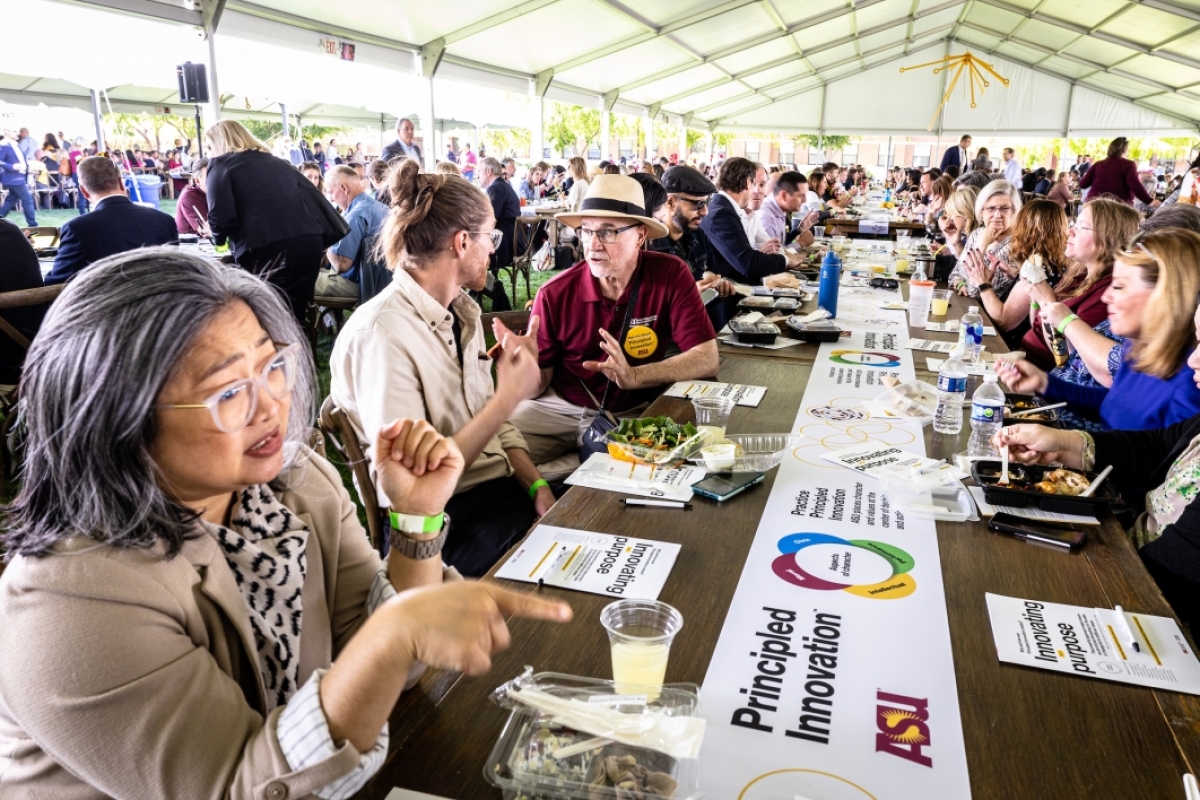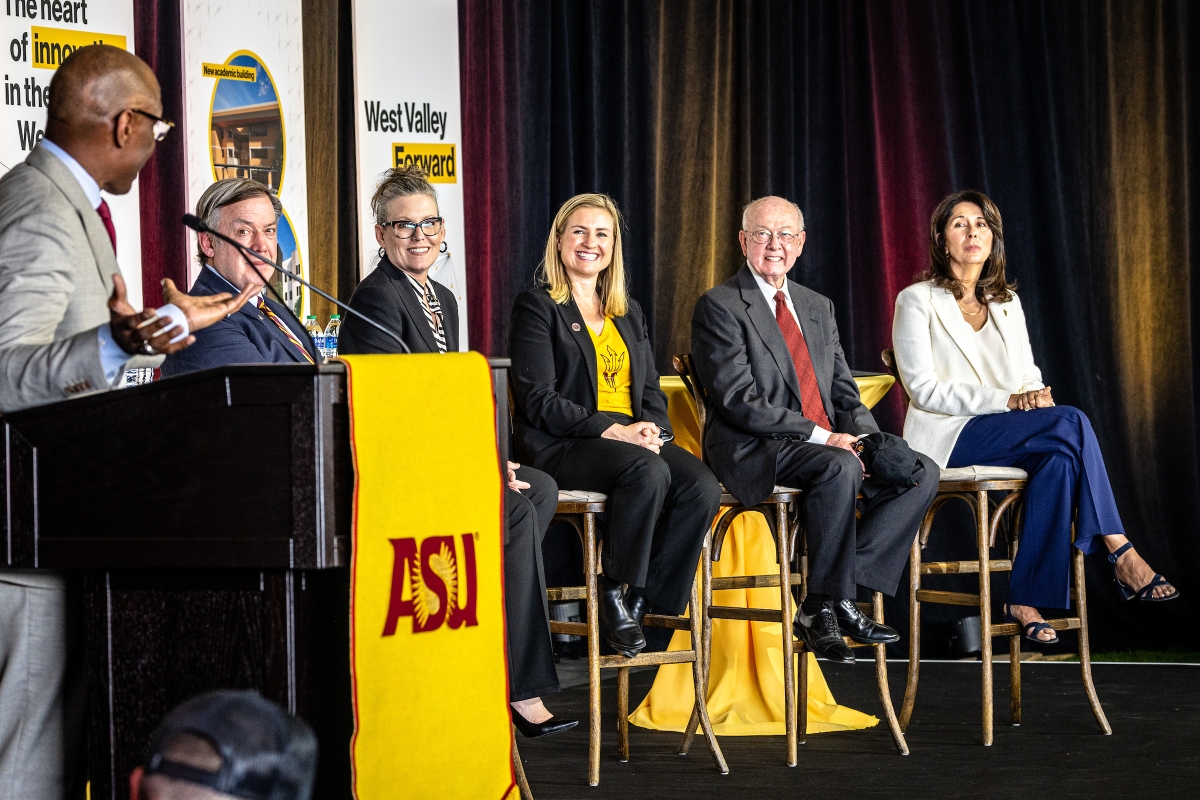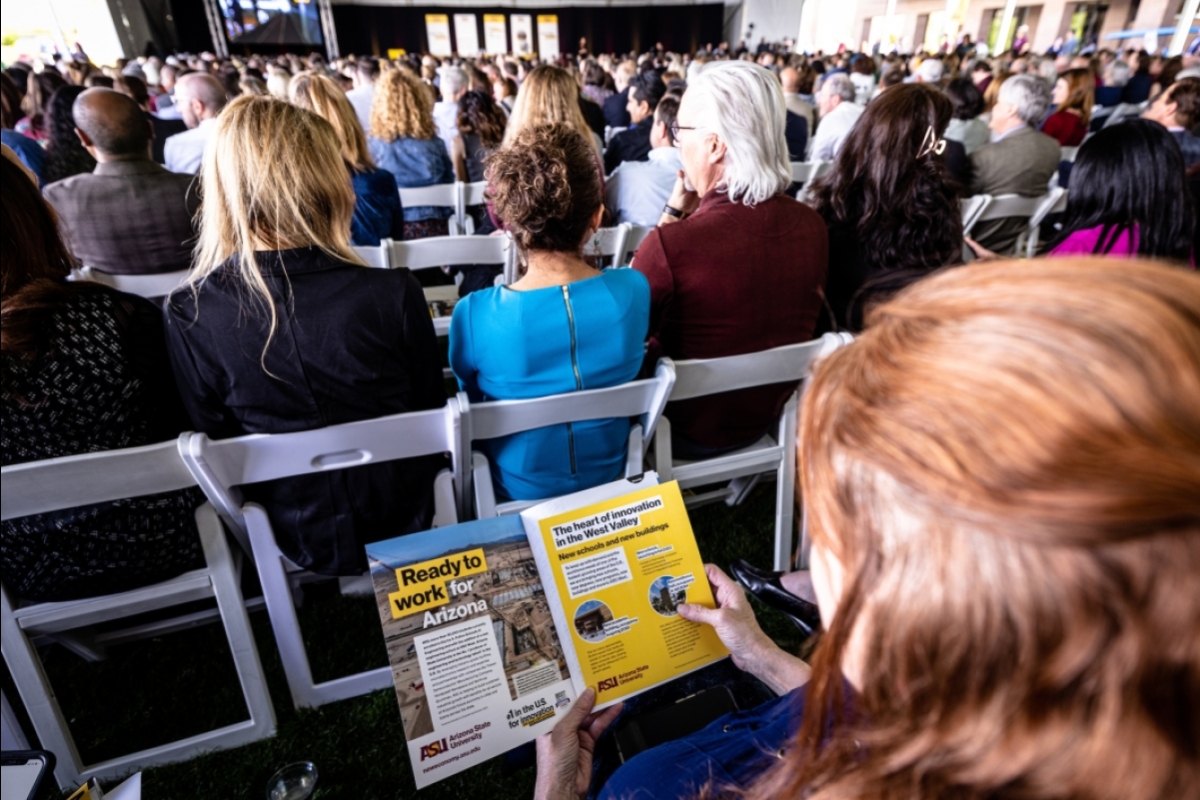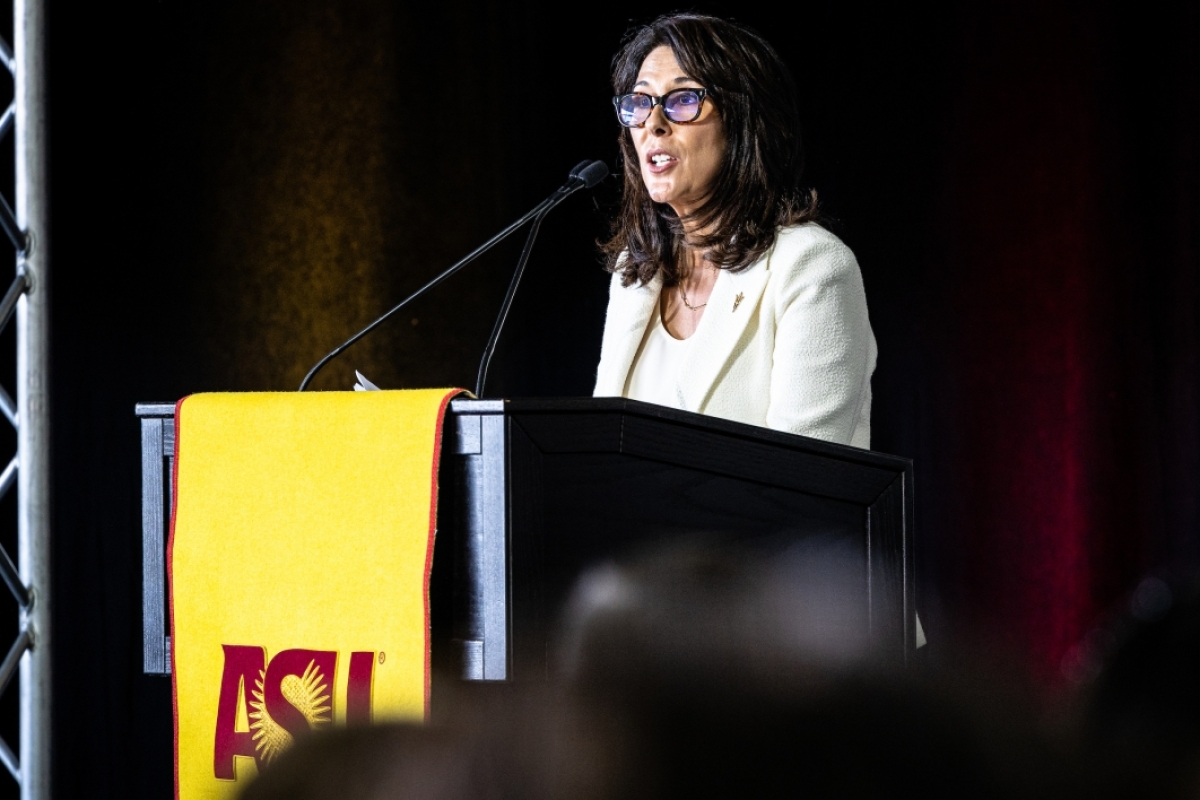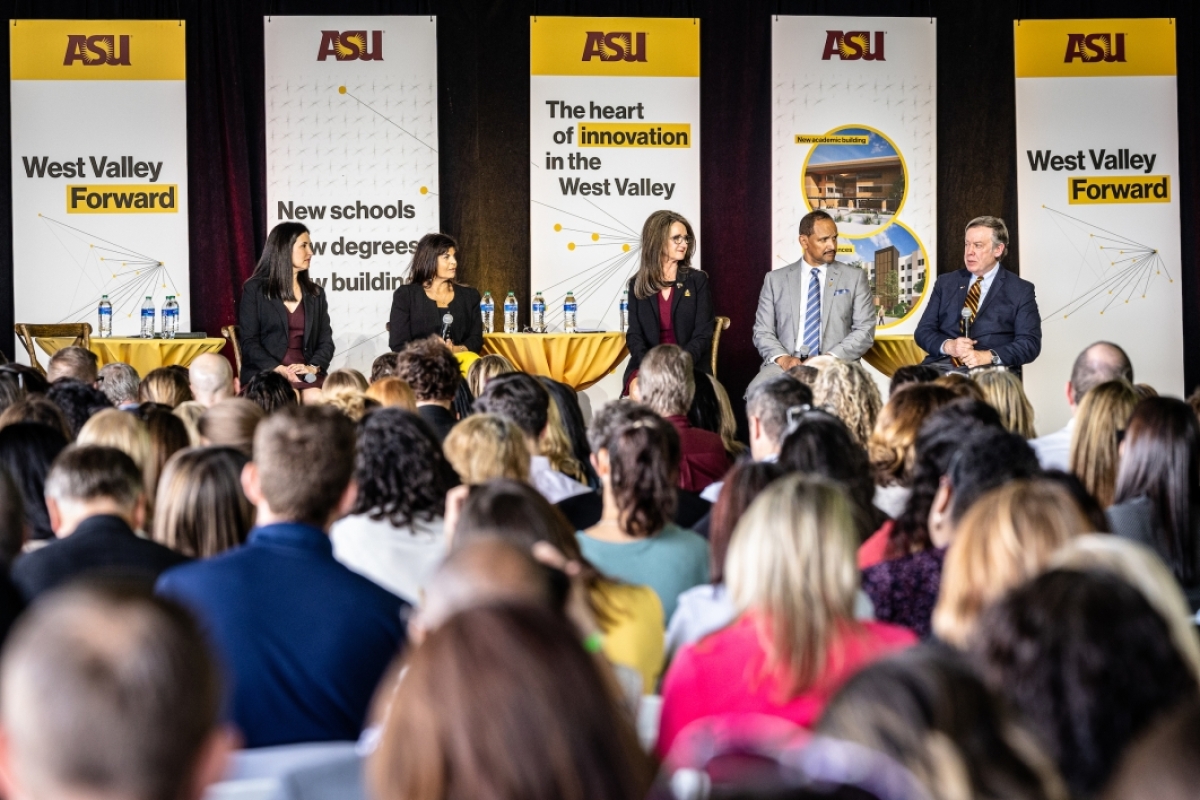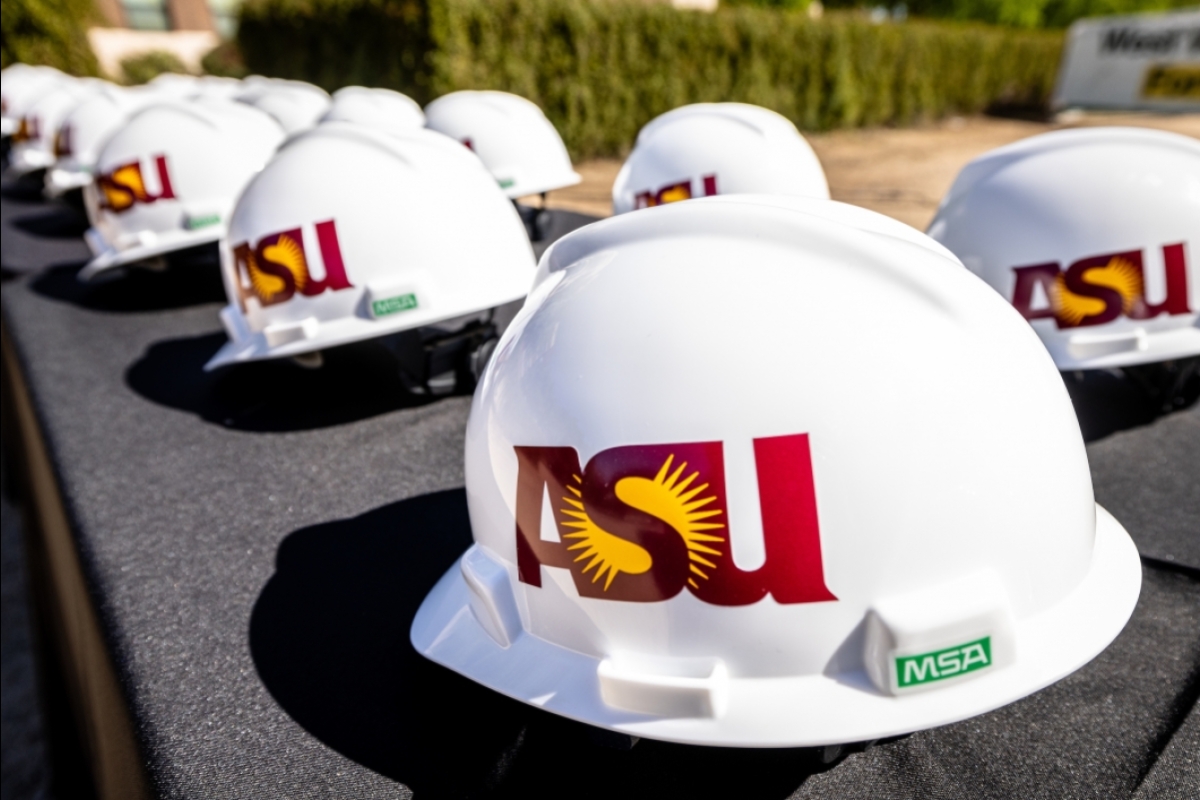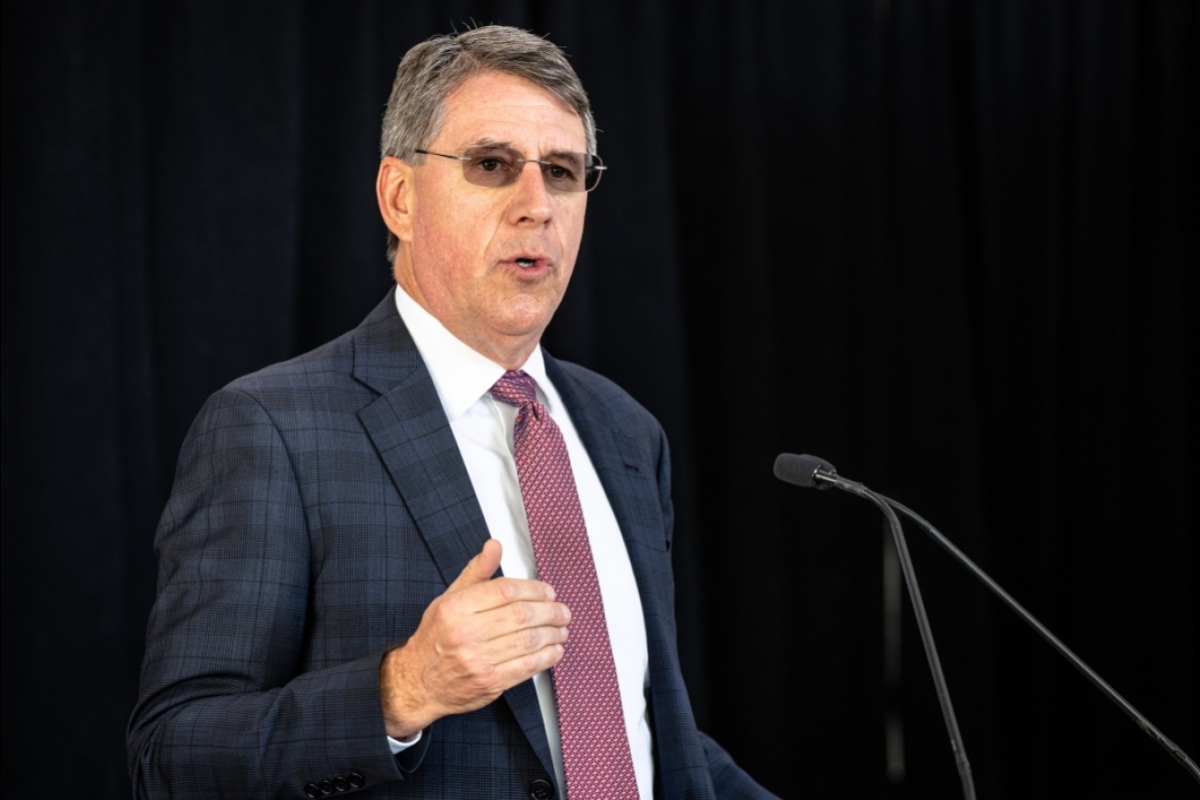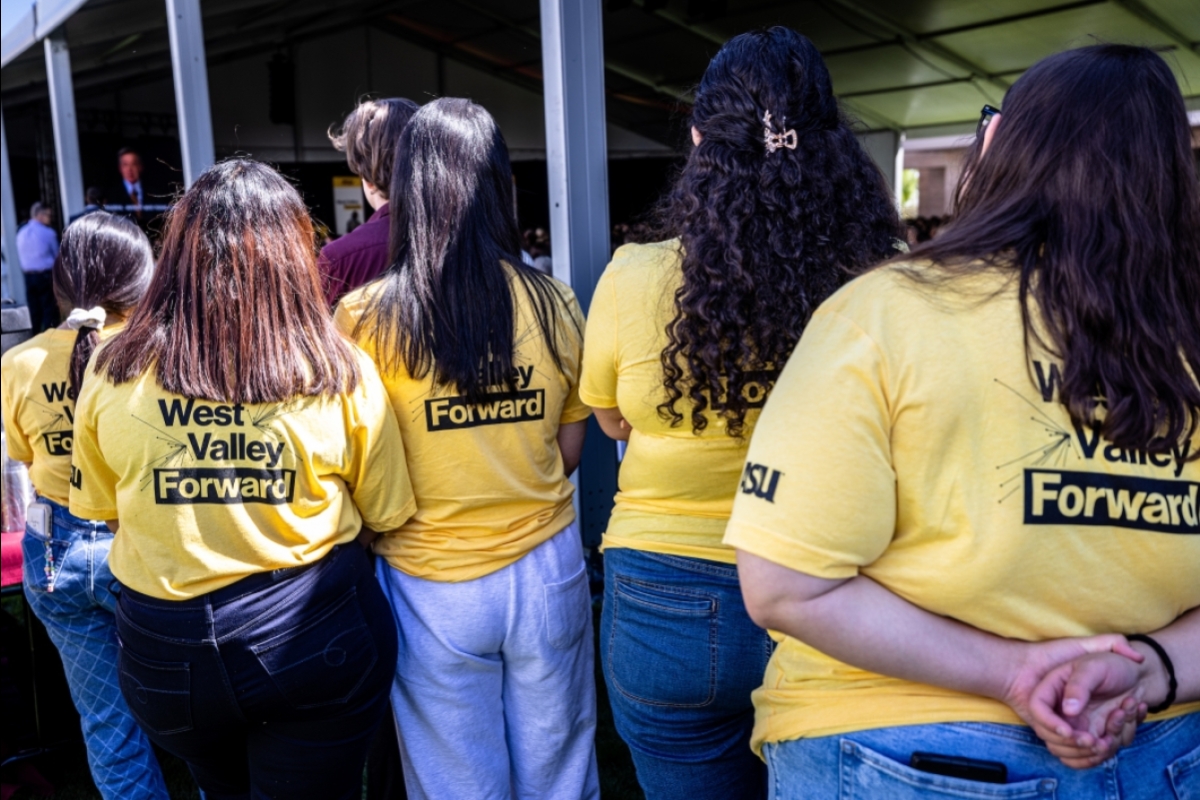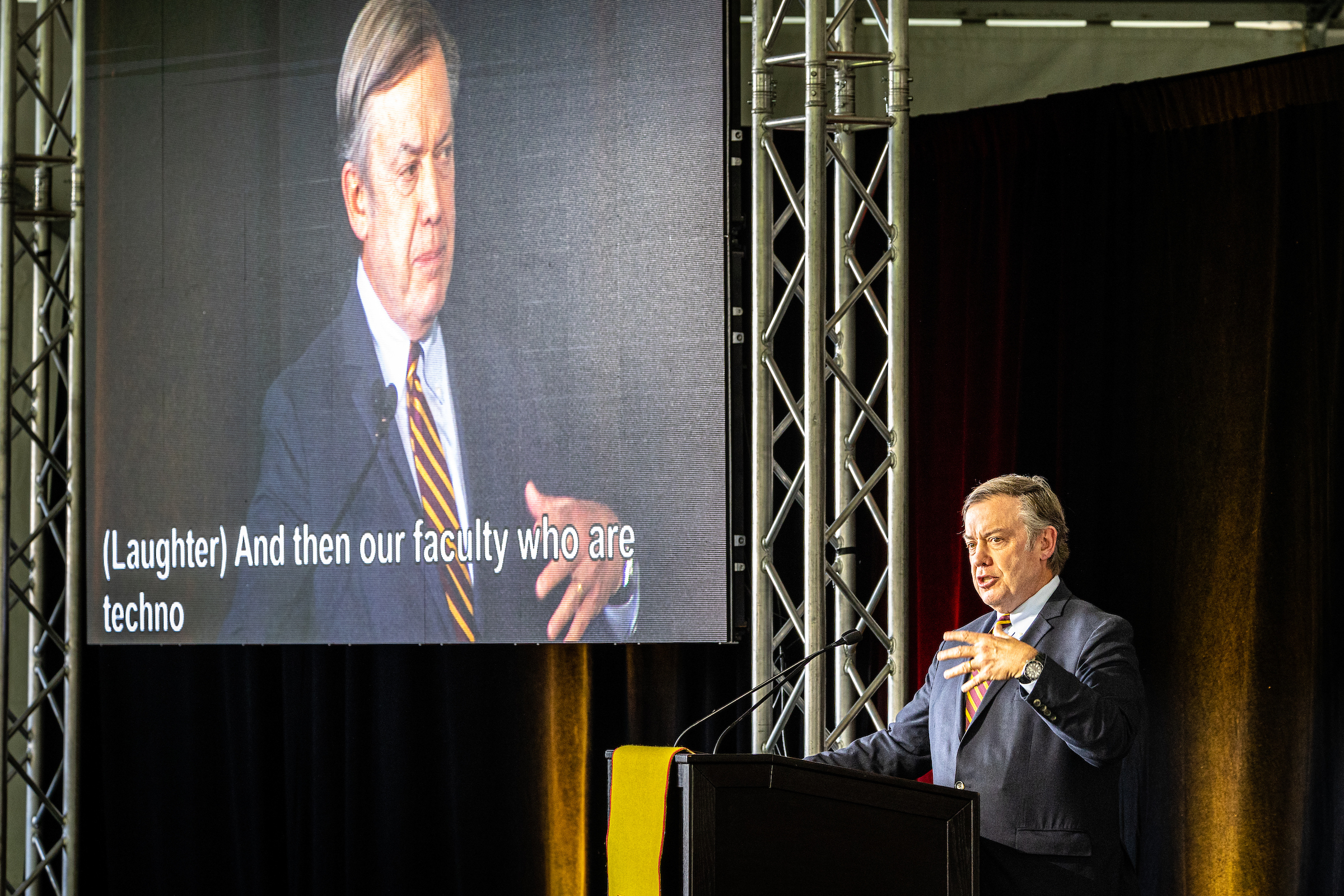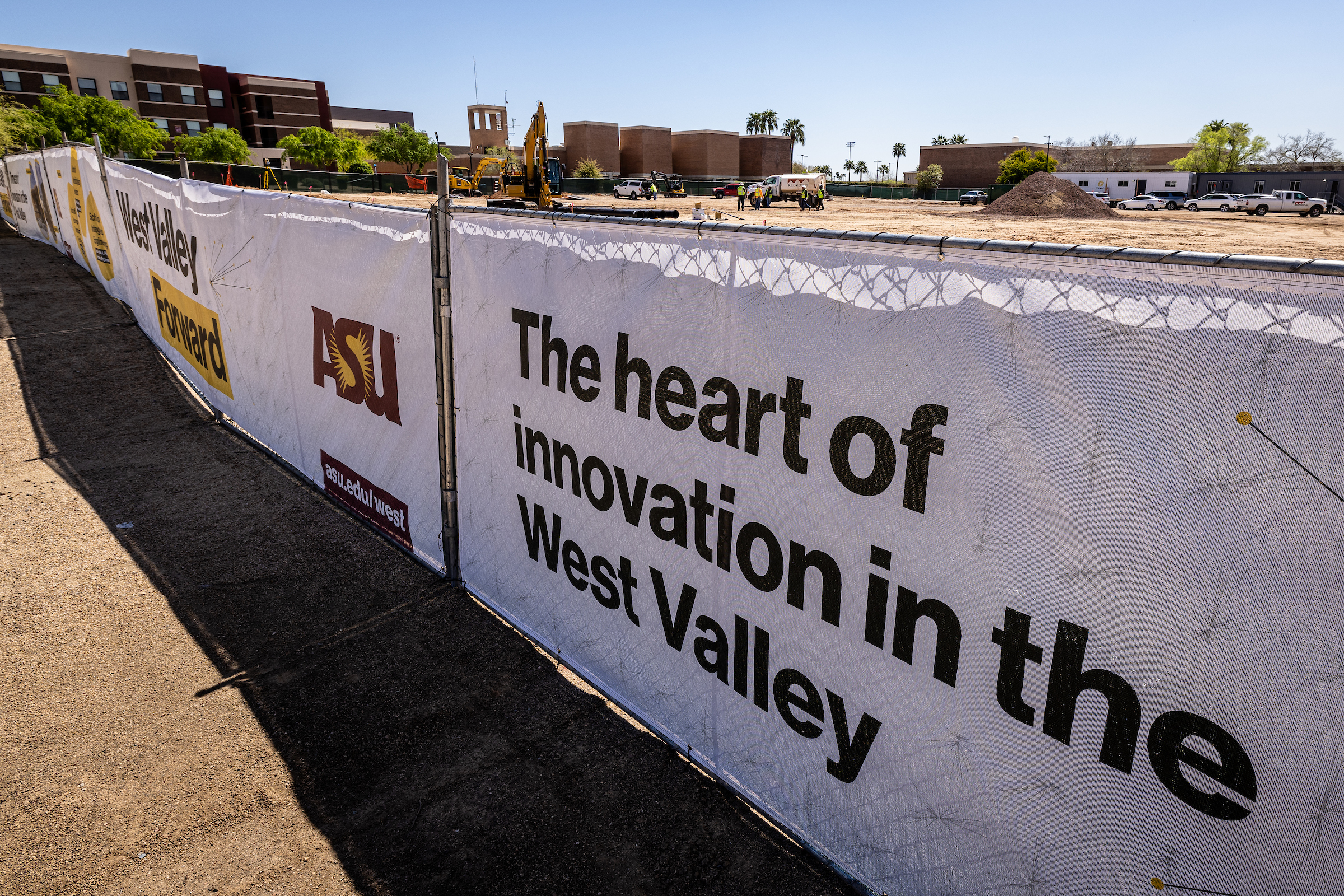ASU's West campus expanding to serve the evolving West Valley
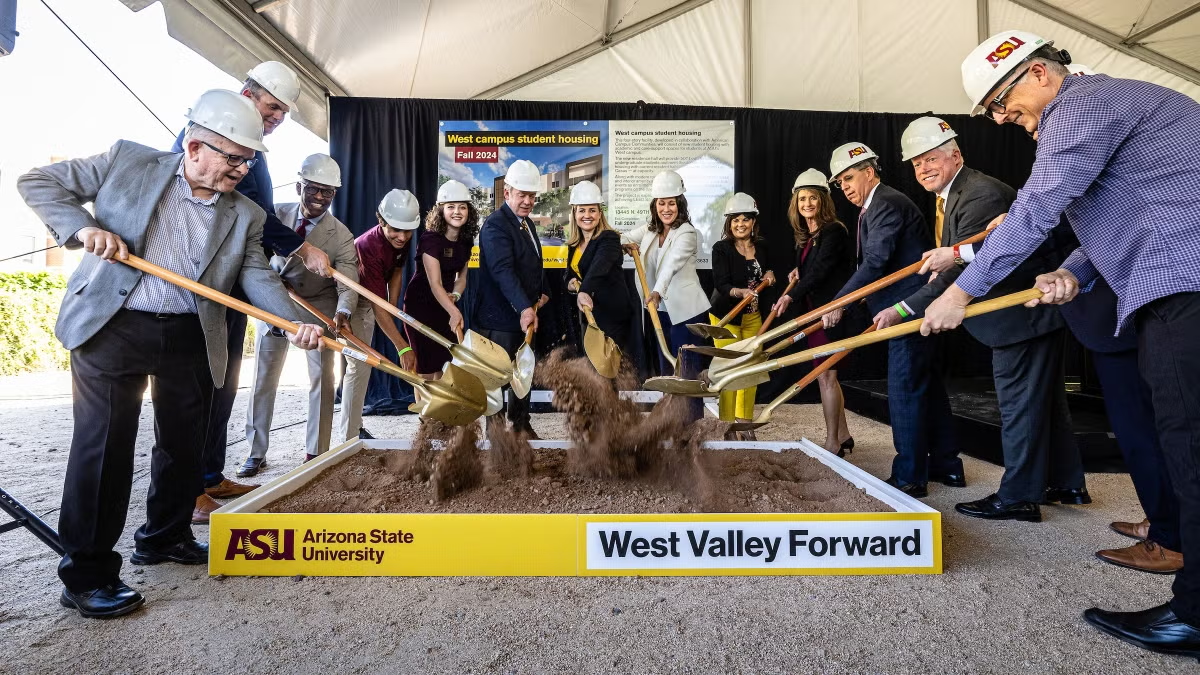
Editor’s note: This story is featured in the 2023 year in review.
Arizona State University celebrated its West campus on Wednesday by kicking off a large-scale project that will add three new academic schools and two new buildings.
The event, on the lawn in front of the Sun Devil Fitness Complex, was called “West Valley Forward” and highlighted ASU’s commitment to meeting the educational and economic growth needs of the booming West Valley.
ASU, which offers more than 120 degree programs at the West campus, is planning to grow enrollment at that campus from the current 5,000 students to about 15,000.
Arizona Gov. Katie Hobbs told the crowd that ASU's West campus will produce graduates to fuel the dynamic growth of industry in the West Valley, which has expanded to include semiconductors and solar power.
“Word is getting out about what Arizona and the West Valley have to offer, and I couldn’t be more excited, and we couldn’t realize this economic growth without ASU West,” she said.
Video by Josh Belveal/Media Relations and Strategic Communications
ASU Executive Vice President and University Provost Nancy Gonzales noted that the West campus is nearly 40 years old, established in 1984.
“The Valley was a very different place in those days — much of the land west of the I-17 was agricultural and sparsely populated,” she said.
In the decades that followed, the West Valley grew from 700,000 to 1.8 million residents while ASU transformed into a research and innovation powerhouse that’s a resource for the communities it serves, she said.
“This shared history brings us to a moment where ASU’s commitment to the citizens and communities of the West Valley requires a new level of engagement, resources and vision, and that’s why we’re here today,” Gonzales said at the event Wednesday, which included a picnic centered on the newest design aspiration, Principled Innovation; speeches; a panel discussion; and a ceremonial groundbreaking for the two new buildings.
Arizona Gov. Katie Hobbs, who has a Master of Social Work from ASU, said at Wednesday's celebration: “Days like today make me proud to be a Sun Devil.” Photo by Charlie Leight/ASU News
New programs
Three new schools, in business, forensics and engineering, will be added to the West campus starting in the fall 2023 semester:
• The School of Technology, Innovation and Entrepreneurship in the W. P. Carey School of Business: This new school, pending approval by the faculty senate in April, will help students develop an entrepreneurial mindset and include project-based coursework and service opportunities in the West Valley. Two new bachelor’s degrees will be added — in entrepreneurial leadership and in applied business and technology solutions. The W. P. Carey School currently offers 11 undergraduate degrees, two graduate degrees and two certificates at the West campus.
• The School of Interdisciplinary Forensics in the New College of Interdisciplinary Arts and Sciences: Forensics is the most popular major at the West campus. Since 2016, over 2,000 students have earned degrees in one of five forensics programs — three undergraduate and two master’s degrees programs. These programs will now be housed together in the new school, which will strengthen the forensics focus and align resources at the West campus. ASU will extend forensics applications across traditional and nontraditional disciplines. While forensics plays a vital role in the administration of justice, it is a highly interdisciplinary field, encompassing psychology, engineering, nursing, accounting, anthropology, biology and the environment. The new school will blend scientific rigor and technical training specifically to address system inequities and safeguard human rights.
• The School of Integrated Engineering in the Ira A. Fulton Schools of Engineering: This new school will provide STEM opportunities in the underserved West Valley with a Bachelor of Science in engineering science — a flexible, multidisciplinary program that integrates a foundation in math, science and engineering, with a specialization in a chosen engineering concentration. Graduates will be prepared for careers in engineering or science as well as business professions that interact with technical specialists. With the Fulton Schools having a presence in the West Valley, the region's schools, nonprofits and businesses will benefit from its Fulton Difference Programs, which include engineering projects in community service, student organizations, K–12 programs and the Grand Challenge Scholars Program.
The two new buildings will include a four-story, 55,000-square-foot academic facility that will house student gallery space, computer labs, faculty offices and future growth spaces, and is expected to be finished in spring 2025. A 500-bed, 134,264-square-foot residence hall is scheduled to open for the fall 2024 semester. Currently, about 800 students live at the West campus. Both buildings are expected to be LEED Silver certified.
Besides adding the new degree programs and buildings at the West campus, ASU also will create the Education Complex at ASU, which will be part of Mary Lou Fulton Teachers College. The new initiative will be a space for collaboration on new ideas and educational innovation through social embeddedness. It will be dedicated to shaping the big questions and global trends affecting the future of education.
The Education Complex will focus on developing a network of community groups with an emphasis on diversity in perspectives and approaches. The groups will include representatives from preschool, K–12, higher education, community-based organizations, business, students, nonprofits, donors and other sectors.
The complex will include physical space that will be flexible, organic and open, allowing shifts into classrooms, educational demonstration spaces or lab sites. Mobile spaces will also be created that can be transported into the community.
Expanding the West campus will have a positive impact on the broader community, according to Todd Sandrin, vice provost of ASU's West campus and dean of the New College of Interdisciplinary Arts and Sciences.
“By providing higher education opportunities for more students, we advance social and economic mobility and contribute to the development of a more diverse and educated workforce,” Sandrin said ahead of Wednesday's festivities. “This has direct benefits not only for individual students and their families, but for our wider community, including increased innovation, creativity and economic growth by providing employers a significant workforce critical to their success.”
Building on a strong history
The West campus was approved by the state Legislature and signed into law by then-Gov. Bruce Babbitt on April 18, 1984. Arizona had a population of just over 3 million then, compared with 7.5 million now.
The campus, in the northwest corner of Phoenix, borders the city of Glendale. When it was established in the 1980s, the land west of Interstate 17 was agricultural and sparsely populated.
Decades of rapid growth followed. The West Valley now encompasses 15 communities, is home to nearly 1.8 million Arizonans and will capture more than half of Maricopa County's future growth. Rich in transportation, rail, water and technology investments with large employers in health care, advanced business, manufacturing, information technology, aerospace, defense and logistics, the West Valley is also a hub for technology entreprenseurship and innovation. Technology startups increased 38% from 2021 to 2022.
Over the years, the West campus has grown to become a hub for learners of all ages, supporting K–12 learners through ASU Prep Local, the Herberger Young Scholars Academy, campus-based youth programs, and local school and community partnerships. The West campus is also one of four sites for ASU's Osher Lifelong Learning Institute, which offers short, high-level, non-credit courses for adults over 50.
It's all part of the evolving mission of the university.
'A people's university'
ASU President Michael Crow said Wednesday that he’s often asked why a university that’s so large would continue to expand. More than 20 years ago, before he took over as president of ASU in 2002, he sat down and studied the Arizona Constitutional Convention.
“In 1910, a bunch of people got together and decided how they would design Arizona, which had been a territory until that point,” he said.
“They wrote down all the words they said, so I read them.
“Here was the inspiration I came away with, which deeply impressed me and influenced what we’ve been able to do here: Essentially, they said, ‘We’ll have a university, and it’ll be a people’s university. People will have access to it.’ ”
That concept is now embodied in ASU, the University of Arizona and Northern Arizona University.
ASU President Michael Crow shares how ASU's mission is inspired by the people of Arizona during the West Valley Forward event at ASU's West campus on March 29. Photo by Charlie Leight/ASU News
In 1958, Phoenix was outgrowing the original teachers college.
“With a view to the future, we said, ‘Let’s have a new university.’ The Legislature said no. The governor said no. The Board of Regents said no,” Crow said Wednesday.
“The people, by referendum, said yes. No other university was voted into existence by the people.”
That concept has powered ASU’s drive to reach as many learners in as many places and in as many ways as possible, Crow said.
“If you’re not ready for college, we’ll get you ready for college,” he said. “If you never finished college, we’ll help you finish college.
“What we’re doing on the ASU West campus is related to our design as the people’s university. We’re going to find a way for jobs for everyone and a path to dignity for everyone, in every possible way.”
Policymakers share their goals
Phoenix Mayor Kate Gallego said that the area west of I-17 is leading the country in technology, especially with the $40 billion Taiwan Semiconductor Manufacturing Company project in northwest Phoenix.
“We’re taking it to the next level today with these new programs that will take us into the decades to come and show that we are a leader in advanced thinking,” she said.
Gallego said that TSMC looked at many places before deciding on Arizona, and the company was impressed by ASU.
“They told me what sealed the deal were the people and the programs at ASU that let students learn the most advanced technology so they can go into the most advanced jobs,” she said.
The West campus is critical for increasing educational attainment in the West Valley, according to Larry Penley, a member of the Arizona Board of Regents. In 2015, the state set a goal — called Achieve 60 AZ — of having 60% of adults have postsecondary attainment by 2030, such as technical training, community college, bachelor’s degree or advanced degree.
“Today we stand at about 46%. We’re a long way from getting where we need to go,” he told the crowd Wednesday.
Penley said that only 19% of Arizona’s ninth-graders end up getting a college degree within six years of graduating from high school, and it will take more investment by the state to improve that. Florida offers a billion dollars in scholarship money for high school graduates to attend state universities while Arizona offers $20 million, he said.
“We would need to be at nearly $400 million to be equal to what Florida is doing today,” he said.
The event included a panel discussion on the future of the West Valley. Among the comments:
Sintra Hoffman, president and CEO of WESTMARC: She said the West Valley has a large talent pool — 38% of the metro Phoenix area’s health care workers and 28% of its workers in finance, insurance and banking live there. However, 70% of workers in the West Valley commute east for work.
“What we need from ASU are specific programs to have employable graduates who can live here and work here and contribute to the community and to meet the needs of the companies we’re trying to attract.”
Ann O’Brien, Phoenix City Council member: She praised the collaboration and partnerships among businesses and government entities in the West Valley.
“After the recession, they said, ‘We’re not going to do this again. We’re going to make Phoenix and the whole Valley a better place and bring different jobs and careers to our citizens.’ ”
She also urged the West Valley to embrace multifamily housing for new graduates of ASU West.
“They need the opportunity not just to rent but to be first-time home buyers,” she said.
Crow said that as a growing area with a diverse population, the West Valley could be an incubator for solving urban problems.
“As the West Valley grows to 2 million or 3 million people, how do we avoid the stresses and strains of other places — the clogged arteries of interstates with massive pollution and people traveling 60 to 80 minutes to get to a job that pays $45,000 a year or less?
“How do you do that? The West Valley could be a place where a lot of these things are figured out.”
Construction is underway on the new 500-bed residence hall at the West campus. Wednesday's groundbreaking was ceremonial; as the hall is due to open before the fall semester, there's no time to delay. Photo by Charlie Leight/ASU News
Top photo: University, political and community leaders perform the ceremonial groundbreaking of the West Campus' new residential hall on Wednesday, March 29. Photo by Charlie Leight/ASU News
More Law, journalism and politics
Law experts, students gather to celebrate ASU Indian Legal Program
Although she's achieved much in Washington, D.C., Mikaela Bledsoe Downes’ education is bringing her closer to her intended destination — returning home to the Winnebago tribe in Nebraska with her…

ASU Law to honor Africa’s first elected female head of state with 2025 O’Connor Justice Prize
Nobel Peace Prize laureate Ellen Johnson Sirleaf, the first democratically elected female head of state in Africa, has been named the 10th recipient of the O’Connor Justice Prize.The award,…

Native Vote works to ensure the right to vote for Arizona's Native Americans
The Navajo Nation is in a remote area of northeastern Arizona, far away from the hustle of urban life. The 27,400-acre reservation is home to the Canyon de Chelly National Monument and…
